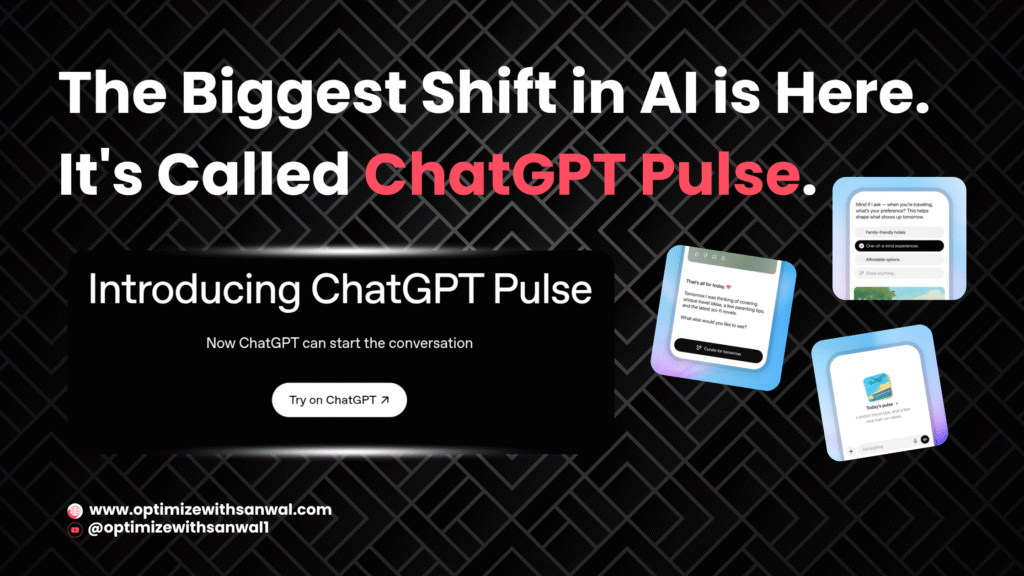When the CEO of OpenAI says he’s launching his “favorite feature so far,” it’s a good idea to pay attention . On September 25, 2025, Sam Altman did just that, announcing ChatGPT Pulse—a feature that represents a fundamental shift from reactive to proactive AI . This isn’t just a minor update; it’s a look into the future of the personal AI assistant.

As a strategist who relies on these tools daily, my job is to look past the announcement and analyze the strategic implications. In this deep dive, I’m going to synthesize all the available information—from Sam Altman’s initial tweets to the official OpenAI post—to give you my take on what Pulse is, how it will change our workflows, and why it’s a glimpse into the future of all AI.
What is the Core Problem Pulse is Designed to Solve?
Before we get into the features, we have to understand the “why.” For years, AI chatbots have had a fundamental limitation: the burden is always on you to know what to ask for. This reactive model is powerful, but it’s limited by your ability to craft the perfect prompt. Pulse is OpenAI’s first major step toward solving this problem by allowing the AI to start the conversation.
How Does the Daily Pulse Experience Actually Work?
The core of Pulse is a process OpenAI calls “asynchronous research”. Here is a practical breakdown of how it functions:
- It Works Overnight: Each night, the system synthesizes information from your ChatGPT memory, your recent chat history, and any direct feedback you’ve given it. It can also use connected apps, like your calendar, if you grant permission.
- It Delivers Daily Updates: Every morning, Pulse delivers a fresh, curated set of updates directly in the app.
- It Uses Visual Cards: These updates are presented as “topical visual cards” that are easy to scan. An example from the launch shows a card titled “Today’s pulse” with suggestions for “London travel tips, and a few new trail run ideas”.
- Updates are Ephemeral: The daily updates are available for that day only unless you save them as a chat or ask a follow-up question, which adds them to your conversation history.
What Makes Pulse a Smarter Assistant? (My Analysis)
This feature is more than just a newsfeed. Based on the details, its intelligence comes from two key areas that create a powerful partnership between you and the AI.
- The Power of Implicit Learning Pulse is designed to learn from your casual conversations. Sam Altman gave the examples of mentioning “I’d like to go visit Bora Bora someday” or “My kid is 6 months old” . Pulse remembers these details and might proactively surface useful updates in the future, like travel deals or articles on developmental milestones. This is the key to treating it like a “super-competent personal assistant” .
- The Curation & Feedback Loop You are not just a passive recipient; you are the director. The system includes a “curate for tomorrow” button that allows you to give it direct instructions, like “focus on professional tennis updates tomorrow”. You can also give any card a thumbs up or down, and Pulse remembers your feedback to make the next day’s update more useful. This level of personalization is a key battleground for AI dominance. To see how other tools stack up, you can read my full breakdown in
Perplexity AI vs. ChatGPT: Which AI Tool is Right for You in 2025?.
Who Developed Pulse and What Are Its Limitations?
To add authority and transparency, the announcement gives credit to the team members who built the feature, including Christina Hart (@ChristinaHartW) and Samir (@_samirism) . OpenAI also notes that they partnered with college students in the ChatGPT Lab to gather early feedback, which led to improving the curation features. One student, Isaac Seiler, was quoted as saying the update was “several logical steps ahead” of his own thinking.
OpenAI is also clear about the limitations. Pulse is being released as a preview and “won’t always get things right”. It might suggest tips for a project you’ve already completed, but the team plans to learn from early use before rolling it out more widely from Pro to Plus subscribers, and eventually to everyone.
What Does Pulse Signal About the Future of AI?
From my perspective as a strategist, this is the most important part of the announcement. Pulse is the first step toward a new paradigm where AI can research, plan, and take helpful actions for you without being prompted for every single step.
The official vision is for ChatGPT to evolve from something you consult into something that “quietly accelerates the work and ideas that matter to you”. Future plans include connecting Pulse to more apps and delivering information at the right moments throughout the day. This proactive future is the direction the entire industry is heading. Understanding the key players is more important than ever, which is why I did a deep data-driven comparison in my guide,
Which is Better: Gemini 2.5 Pro vs. ChatGPT 5?.
My Final Thoughts
The launch of ChatGPT Pulse is a significant evolution. It’s a clear move away from the simple, reactive chatbot and toward the dream of a true digital assistant that anticipates your needs. While it’s still an early preview, the strategic direction is powerful and gives us a clear look at the future of personalized AI.
About Me
I’m Sanwal Zia, a certified SEO strategist and the founder of Optimize with Sanwal. With expertise recognized by prestigious organizations, I focus on building effective search strategies that drive growth. You can connect with me directly on my Website, LinkedIn, Facebook, and Instagram.

